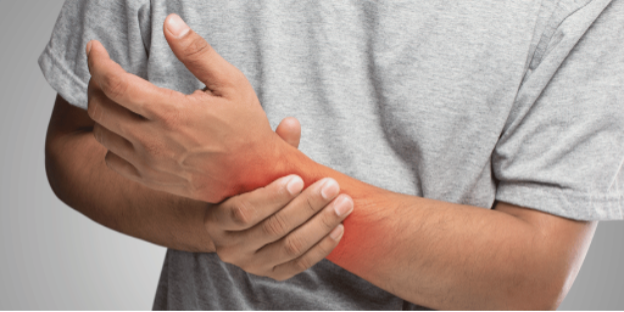Sprained Wrist: Symptoms and Treatment
- Category: Blog
- Posted On:

Your wrists do a lot for you by supporting your hands as they move and flex. But when a traumatic injury occurs that stretches or tears the wrist ligaments, you may experience a sprain.
An injured wrist can happen due to falls, athletic stress or repetitive use. Anyone can sprain their wrist, regardless of their activity level. But not all sprained wrist injuries are the same.
Types of Wrist Sprain
There are different types of wrist sprains, depending on the severity of the injury. Medical professionals use three levels, or grades, to classify the severity of a wrist sprain. These grades are:
- Grade 1 Sprain: This category is for mild injuries when a person has stretched but not torn the ligaments.
- Grade 2 Sprain: A moderate grade 2 injury happens when the stretched ligaments have also partially torn. At this level, some people may lose some wrist function.
- Grade 3 Sprain: If your injury includes a complete tear or ligament separation from the bone, you have suffered a severe sprain. In some cases, this kind of sprain can also cause a fracture. Medical or even surgical attention is necessary to repair this type of sprain.
Symptoms of a Sprained Wrist
While the most common symptom of a sprained wrist is pain, there are other symptoms you may experience after an injury. Other signs of a sprained wrist include:
- Swelling on the affected wrist.
- Soreness at the point of injury or in the general wrist area.
- Warmth in the joint area.
- Weakness or difficulty moving the wrist.
- Tearing or popping sounds when you try to move it.
- Bruising.
Not everyone experiences a sprained wrist injury in the same way. Some people may dismiss the symptoms as minor. But even if the discomfort seems mild, you may still have a partial tear, full tear or fracture.
If a moderate or severe wrist injury occurs, a person can develop long-term problems without urgent medical treatment. In some cases, a wrist sprain may need surgery to prevent complications.
Even if you have a mild wrist injury, you may want to see a doctor if the pain persists, or the injury does not get better quickly. Your doctor can assess the injury and help you get the appropriate care.

Sprained Wrist Treatment
A doctor can examine your wrist and perform tests to decide if you need more treatment. But the doctor will also take time to learn about your general health and if you have injured the wrist before.
If your injury is minor, you can treat the symptoms at home. A splint or wrapping the wrist to compress it can temporarily reduce your range of movement and help with the pain. Resting the sprain and applying ice can help reduce swelling and pain. It's also a good idea to try elevating your wrist as much as possible. Finally, over-the-counter pain relievers can reduce swelling and pain at the injury site.
But if you still have pain or swelling after 48 hours, you may need more medical attention. Moderate or severe wrist sprains may need surgery and rehabilitation. Your doctor may also suggest exercises to help you regain full movement and flexibility after the injury.

Seek Medical Help for Your Wrist Injury at ProMedica Toledo Hospital Emergency and Urgent Care
ProMedica Toledo Hospital Emergency and Urgent Care provides patients with quality care and services. Staff are ER-trained to determine patient conditions, and patients only pay for the level of service they receive – either ER or urgent care. The emergency department is open 24/7 and the urgent care clinic is open from 7 a.m. to 9 p.m. daily. You don't need an appointment. All walk-ins are welcome.
ProMedica Toledo Hospital Emergency and Urgent Care is located at 1075 Medical Center Parkway, Maumee, OH 43537.
